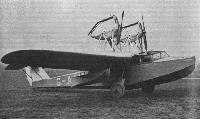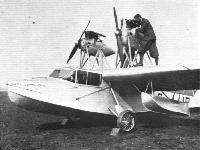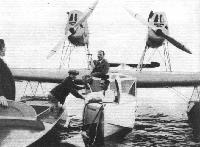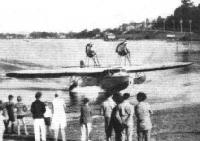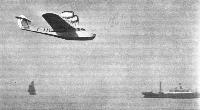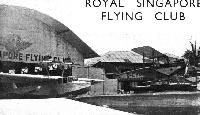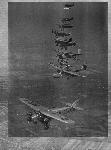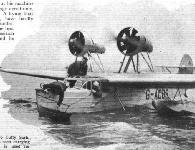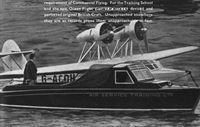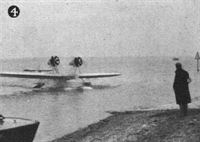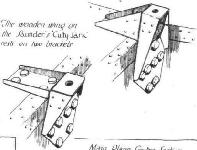
Описание
Страна : Великобритания
Год : 1929
Летающая лодка
Легкая летающая лодка-амфибия
Варианты
- Saunders-Roe - Cutty Sark / A.17 - 1929 - Великобритания
- Saunders-Roe - Cloud / A.19 - 1930 - Великобритания
Saro A.17 Cutty Sark
В 1928 году британский энтузиаст авиации сэр Эдвин Эллиот Вердон Ро купил компанию «S.E. Saunders Ltd»; фирма изменила название на «Saunders-Roe Ltd», но очень часто именовалась сокращенно - “Saro”.
Первой конструкцией, изготовленной на фирме под новым названием, стала легкая летающая лодка-моноплан A.17 Cutty Sark, рассчитанная на перевозку трех пассажиров и одного летчика. Первый полет прототип с двумя моторами ADC Hermes I мощностью по 105 л. с. выполнил 4 июля 1929 года.
Позже лодка стала амфибией - на ней установили убираемое колесное шасси. Вслед за прототипом построили еще 11 гидропланов A.17, отличавшихся силовой установкой - на большинстве стояли моторы de Havilland Gipsy II мощностью по 120 л. с., но на трех последних установили более мощные Armstrong Siddeley Genet Major I.
За исключением одного самолета (G-ABVF) все летающие лодки выполняли полеты с японскими летчиками на линии Япония - Сан-Франциско. От более ранних A.17 они отличались мотором - Armstrong Siddeley Lynx IVC мощностью 240 л. с., увеличенным запасом топлива и отсутствием колесного шасси. Карьера большинства A.17 выдалась длинной, три лодки в Хэмбле эксплуатировались с 1933 по 1938 год.
ТАКТИКО-ТЕХНИЧЕСКИЕ ХАРАКТЕРИСТИКИ
Saro A.17 Cutty Sark
Тип: легкая летающая лодка-амфибия
Силовая установка: два звездообразных мотора Armstrong Siddeley Genet Major I по 140 л. с. (104 кВт)
Летные характеристики: максимальная скорость 172 км/ч; практический потолок 2745 м; дальность 507 км
Масса: пустого 1236 кг; максимальная взлетная 1769 кг
Размеры: размах крыла 13,72 м; длина 10,46 м; высота 3,40 м; площадь крыла 29,73 м2
Описание:
- Saro A.17 Cutty Sark
- Flight, June 1929
BRITISH AIRCRAFT AT OLYMPIA - Flight, April 1930
AIRCRAFT FOR THE PRIVATE OWNER - Flight, November 1932
British Aircraft - Flight, April 1936
MODERN LIGHT AIRCRAFT REVIEW
Фотографии
-
Flight 1930-04 / Flight
SAUNDERS "CUTTY SARK" (2 A.D.C. "Hermes").
-
Aeroplane Monthly 1987-04 / A.Lumsden, T.Heffernan - Per Mare Probare (2)
The unmarked prototype Cutty Sark moored off the Saunders-Roe works at East Cowes, Isle of Wight.
-
Flight 1930-06 / Flight
Регистрационный номер: G-AAIP [7] THE FIRST PRIVATELY-OWNED "CUTTY SARK": Mr. Norman Holden has the distinction of being the first private individual to purchase one of the Saunders-Roe "Cutty Sark" Amphibians with "Hermes" engines. Last week he visited Hanworth in his machine, which carries the identification letters G-AAIP.
-
Aeroplane Monthly 1987-04 / A.Lumsden, T.Heffernan - Per Mare Probare (2)
Регистрационный номер: G-AAIP [7] The original Saro Cutty Sark, G-AAIP, with "uncorrugated" hull and Cirrus Hermes I engines.
The prototype Cutty Sark, painted blue and bearing its registration letters. G-AAIP was scrapped in 1935. -
Flight 1930-05 / Flight
Регистрационный номер: G-AAIP [7] We show a selection of views of Mr. Norman Holden's "Cutty Sark." The clear view forward from the cabin can be seen, as also the wide track of the undercarriage. On the right is Mr. Holden, Mrs. Holden and Mr. E. Hordern (pilot).
-
Flight 1933-08 / Flight
Регистрационный номер: G-AAIP [7] Saro "Cutty Sark" (2 "Gipsy II") four seater.
-
Flight 1931-04 / Flight
Регистрационный номер: G-AAIP [7] A Saro "Cutty Sark" ready to leave Heston on a tour towards Greece, with Lord Lymington, Capt. Balfour, and Flt.-Lt. Pope.
-
Flight 1929-07 / Flight
The Saunders "Cutty Sark" is a small four-seater, twin-engined, flying-boat with metal hull and wooden wing.
-
Aeroplane Monthly 1984-09 / Personal album
Регистрационный номер: G-AAVX [5], VR-SAA [5] Saunders Roe A.17 Cutty Sark was originally registered to the Hon. A. E. Guinness at Southampton. It began life as a flying boat but was later modified to an amphibian and sold to the RSFC, being re-registered as VR-SAA in 1934.
-
Aeroplane Monthly 1987-04 / A.Lumsden, T.Heffernan - Per Mare Probare (2)
Регистрационный номер: G-AAVX [5], VR-SAA [5] A PRIVATE OWNER'S AIR YACHT: The Hon. A. E. Guiness now owns another air yacht, a Saunders-Roe "Cutty Sark," which we show here, about to set out from Cowes on a trial flight.
Cutty Sark G-AAVX spent much of its life with the Royal Singapore Flying Club. The tropical conditions caused the plywood-covered wing to warp and 'VX was scrapped in 1935. -
Aeroplane Monthly 1991-07 / J.Stroud - Wings of Peace
Регистрационный номер: G-AAVX [5], VR-SAA [5] The fourth Cutty Sark as G-AAVX. It went to the Royal Singapore Flying Club as VR-SAA.
-
Aeroplane Monthly 1984-09 / Personal album
Регистрационный номер: G-AAVX [5], VR-SAA [5] -
Flight 1931-11 / Flight
Регистрационный номер: G-AAVX [5], VR-SAA [5] THE "CUTTY SARK" AT SINGAPORE: The Singapore Flying Club is using a Saro "Cutty Sark" - loaned by the Straits Settlements Government - for advanced training.
-
Flight 1930-11 / Flight
Saro Cutty Sark 4-seater flying-boat.
-
Flight 1929-09 / Flight
A BRITISH VISITOR AT LA BAULE: Air Vice-Marshal Sir Sefton Brancker flew to La Baule in the Saunders "Cutty Sark" flying boat (two "Cirrus" Hermes engines) seen here after arriving from England.
-
Flight 1931-04 / Flight
THE "CUTTY SARK" IN TASMANIA: The Matthews Aviation Saro "Cutty Sark" amphibian arriving at Hobart after a flight from Australia on December 18 last.
-
Flight 1929-11 / Flight
THE MODERN VERSION: The old "Cutty Sark" was one of the most famous of the China Tea Clippers. The Saunders-Roe "Cutty Sark" is just as much of a thoroughbred. A four-seater, with "Cirrus-Hermes" engines, she should be almost the ideal "Air Yacht."
-
Flight 1929-12 / Flight Advertisements
Регистрационный номер: G-AAIP [7] In the Saro "Cutty Sark" Messrs. Saunders-Roe Ltd. have produced an ideal 4-seater cabin flying boat for the private owner. The rudder and elevators are the only portions of the machine which are fabric covered - they are, of course, doped with Cellon. The wings are of plywood and the hull of aluminium alloy - both are finished with Cerric Cellulose Lacquer, which is specially designed to give complete protection against sea-water corrosion, etc.
-
Flight 1930-10 / Flight
Регистрационный номер: G-ABBC [3] THE SARO AMPHIBIAN FAMILY: On the left is the "Cutty Sark," in the centre the latest "Windhover," and on the right the "Cloud."
Другие самолёты на фотографии: Saunders-Roe Cloud / A.19 - Великобритания - 1930Saunders-Roe Windhover / A.21 - Великобритания - 1930
-
Aeroplane Monthly 1991-07 / J.Stroud - Wings of Peace
Регистрационный номер: G-ABBC [3] G-ABBC Progress, the Cutty Sark used by British Amphibious Air Lines on the Blackpool - Isle of Man services, in conjunction with Progress buses.
-
Air-Britain Archive 1980-03
Регистрационный номер: G-ABBC [3] Saro Cutty Sark G-ABBC named "Progress", probably with British Amphibious Air Lines.
-
Flight 1931-07 / Flight
Captain S. D. Scott, Saunders-Roe's chief test pilot, who piloted the "Cutty Sark" on her cruise.
-
Flight 1931-07 / Flight
LOCAL INTEREST: The "Cutty Sark," with a few admirers, at Sarajevo.
-
Flight 1933-08 / Flight
AN ARMY MARCHES ON ITS STOMACH: The Napoleonic dictum might be paraphrased in modern times by saying that a club flies on its ground staff.
-
Flight 1933-08 / Flight
ON THE SLIPWAY: A Saro "Cutty Sark" and two "Cirrus-Moths" belonging to the Royal Singapore Flying Club.
Другие самолёты на фотографии: De Havilland Moth Seaplane - Великобритания - 1926
-
Aeroplane Monthly 1991-07 / J.Stroud - Wings of Peace
Регистрационный номер: VH-UNV [2] The second Cutty Sark, with Gipsy Ils, went to Australia as VH-UNV. It crashed on April 5, 1938.
-
Air Pictorial 1957-01 / Photos by request
Регистрационный номер: VH-UNV [2] READER'S QUIZ. Mr. P. Hughes of Portarlington, Vie., asks us to identify this "joyriding" amphibian (VH-UNV) photographed in Australia in the 1930s. It is a Saunders A.17A Cutty Sark four/five-seater of 1929. Mr. A. J. Jackson recalls witnessing the acceptance trials of this second built Cutty Sark at Leigh on 1st February 1930 - bearing a Class B registration L-1. VH-UNV was powered by two 105-h.p. Hermes II inlines. Span 45 ft.; length 34 ft. 4 in.; empty 2,246 lb. ; 3,200 lb. Max. speed, 150 m.p.h. Crashed, 5/4/38, Queensland.
-
Aeroplane Monthly 1987-04 / A.Lumsden, T.Heffernan - Per Mare Probare (2)
Регистрационный номер: S1575 [3] Шестая построенная лодка Saro A.17 Cutty Sark в декабре 1930 года была передана в учебное звено гидросамолетов британских ВВС в Кэлшоте. На лодке стояли моторы Gipsy II, использовалась она как учебная.
Two views of Cutty Sark S1575, used by the Seaplane Training Handling Flight at RAF Calshot. -
Flight 1932-06 / Flight
SARO "CUTTY SARK" AMPHIBIAN: Two de Havilland "Gipsy II" engines.
-
Flight 1930-12 / Flight
Регистрационный номер: S1575 [3] A SERVICE AMPHIBIAN: Four views of the Saro "Cutty Sark" amphibian flying boat (two D.H. "Gipsy II" engines), which has been supplied to the Royal Air Force for specialised training in navigational instruction, as well as permitting additional experience of the amphibian flying boat. It is a standard "Cutty Sark," very fully equipped with instruments and electrical gear, and is arranged as a three-seater machine with full dual control.
-
Flight 1931-01 / Flight
Регистрационный номер: S1575 [3] DECEMBER IN THE SOLENT: The photographs show, on the left, the Saro "Cutty Sark" taking off, and, on the right, alighting. Note the general "cleanness."
-
Flight 1933-07 / Flight
A COOL VIEW: Visitors find the high diving board a good grandstand. F/O. Murray flying past in the "Cutty Sark" of A.S.T. The Avro "Cadets" are also from A.S.T.
Другие самолёты на фотографии: Avro Cadet / Type 631/643 - Великобритания - 1932
-
Flight 1934-05 / Flight
Регистрационный номер: G-ACDR [6] The staggering formation of aircraft was flown by instructors of Air Training Services Ltd in 1934. The aircraft are, from top to bottom: Avro Avian IVM, Avro Cadet, Avro Tutor, D.H.9J, Avro 626, Armstrong Whitworth Siskin III, Armstrong Whitworth Atlas, Saro Cutty Sark and an Avro Five.
Другие самолёты на фотографии: Armstrong Whitworth Atlas / Ajax - Великобритания - 1925Armstrong Whitworth Siskin - Великобритания - 1921Avro Avian / Type 594/616 - Великобритания - 1926Avro Cadet / Type 631/643 - Великобритания - 1932Avro Five / Type 619 / Six / Type 624 - Великобритания - 1929Avro Tutor/Sea Tutor/Prefect / Type 621/646/626 - Великобритания - 1929De Havilland D.H.9J - Великобритания - 1926
-
Air Enthusiast 1996-05 / R.Bonser - Hamble Pictorial. Air Service Training in the 1930s
Регистрационный номер: G-ACDP [3] AST grouping within the huge Avro/AW works building on the southern airfield. Foreground, left to right: Avro 616 Avian IVM floatplane G-ABKB, entered service in March 1931 and served on until being impressed, as instructional airframe 2073M, in February 1940. Saro A.17 Cutty Sark G-ACDP served AST from April 1933 until April 1939 when it was scrapped. Avro 504N G-EBKQ was converted by Avro at Hamble and flew for them in several capacities, the most famous of which was as Bert Hinkler’s mount in the gruelling 1925 King’s Cup which was staged out of Croydon over 1,608 miles and two days in July. In 1930 it was converted to 5040 seaplane status and joined AST, retiring in June 1931 to act as an instructional airframe.
Другие самолёты на фотографии: Avro Avian / Type 594/616 - Великобритания - 1926Avro Avro 504N - Великобритания - 1920
-
Flight 1935-12 / Flight
Регистрационный номер: G-ACDR [6] An amphibian has its advantages. The Cutty Sark descends the new slipway at Hamble while Flt. Lt. Middleton gives instructions from the control cabin. When the tide is out the "Cutty" can be landed on the aerodrome and taxied to its hangar.
-
Flight 1932-05 / Flight
SARO "CUTTY SARKS" FOR CHINA: Two of these machines were shipped recently. They are fitted with two Armstrong-Siddeley "Genet Major" 7-cylinder engines, which give a materially improved performance; extra fuel tanks have been fitted, giving a maximum duration of 7 hours.
-
Aeroplane Monthly 1987-04 / A.Lumsden, T.Heffernan - Per Mare Probare (2)
Регистрационный номер: G-ACDR [6] Air Service Training's Cutty Sark G-ACDR alighting on Southampton Water at Hamble in the summer of 1933. The engines are Genet Majors.
-
Flight 1935-12 / Flight
Регистрационный номер: G-ACDR [6] Picking up moorings: The Saro Cutty Sark is used for preliminary training
-
Air Enthusiast 1996-09 / Round-Out
Регистрационный номер: G-ACDR [6] Saro Cutty Sark G-ACDR and the AST Sea Rover fast tender.
-
Aeroplane Monthly 1987-04 / A.Lumsden, T.Heffernan - Per Mare Probare (2)
Регистрационный номер: G-ACDR [6] Another view of the Genet-powered Cutty Sark G-ACDR, showing its amphibious qualities. The 140 h.p. seven-cylinder Armstrong Siddeley Genet Majors gave the Cutty Sark a cruising speed of 90 m.p.h.
-
Aeroplane Monthly 1991-07 / J.Stroud - Wings of Peace
Регистрационный номер: G-ACDP [3] Air Service Training’s Genet Major-engined Cutty Sark G-ACDP at Hamble in November 1936 while being used to train Empire Flying-boat crews.
-
Aeroplane Monthly 1987-04 / A.Lumsden, T.Heffernan - Per Mare Probare (2)
Регистрационный номер: G-ACDP [3] Air Service Training's Cutty Sark G-ACDP passing the Avro slipway at Hamble. In company with G-ACDR, it was used for instructional navigational and seamanship sorties. G-ACDR was dismantled in 1938; 'DP survived until April 1939.
-
Flight 1938-06 / Flight Advertisements
Регистрационный номер: G-ACDH -
Flight 1938-03 / Flight
The Saro Cutty Sark amphibian used for initial training in flying-boat work.
-
Flight 1935-12 / Flight
The Saro Cutty Sark is seen carrying out some high-speed taxying
-
Flight 1932-05 / Flight
A NEW SARO "CUTTY SARK": Fitted with a direct-drive Armstrong-Siddeley "Lynx" engine, this machine has been equipped with extra tanks and special instruments, and is being flown by the Japanese pilot Yoshihara from San Francisco to Japan - as previously reported in "Flight."
-
Flight 1936-12 / Flight
APPOSITE: Christmas greetings from Air Service Training Ltd. at Hamble. The message is formed by white-overalled humanity "on the hands down," and the "A.S.T." consists of the ten different aircraft types which form the organisation's fleet: Avro V, 626, Avian, Tutors and Cadets; two-seater Siskin; A.W. Atlas; two Cutty Sarks; and D.H. Leopard Moth and Hornet Moth.
Другие самолёты на фотографии: Armstrong Whitworth Atlas / Ajax - Великобритания - 1925Armstrong Whitworth Siskin - Великобритания - 1921Avro Avian / Type 594/616 - Великобритания - 1926Avro Cadet / Type 631/643 - Великобритания - 1932Avro Five / Type 619 / Six / Type 624 - Великобритания - 1929Avro Tutor/Sea Tutor/Prefect / Type 621/646/626 - Великобритания - 1929De Havilland Hornet Moth / D.H.87 - Великобритания - 1934De Havilland Leopard Moth / D.H.85 - Великобритания - 1933
-
Flight 1931-01 / Flight
DECEMBER IN THE SOLENT: The pictures show the cabin specially equipped for service use.
-
Flight 1929-07 / Flight
A REAL "AIR YACHT": The Saunders "Cutty Sark," a flying-boat with two "Hermes" engines, has a four-seater cabin of quite exceptional comfort. Situated ahead of the engines, the noise which reaches the occupants is not offensive, and the transparent covering all round results in a very light and airy cabin.
-
Flight 1929-07 / Flight
One of the seats, with hinged back framework, of the Saunders "Cutty Sark."
-
Aeroplane Monthly 1991-07 / J.Stroud - Wings of Peace
Регистрационный номер: G-AAIP [7] KEITH WOODCOCK’S painting shows the Saro Cutty Sark G-AAIP Silver Bat as operated by Kirston and Mace.
-
Flight 1929-07 / Flight
The water rudders on the "Cutty Sark" are mounted on the sides of the hull, and when operated together, form useful brakes.
-
Flight 1929-07 / Flight
Details of the hull construction of the Saunders' "Cutty Sark." On the left a wing float, and on the right is Shown the bows, with fore hatch open.
-
Flight 1929-08 / Flight
The wooden wing on the Saunders's "Cutty Sark" rests on two brackets
-
Flight 1929-07 / Flight
Saunders "Cutty Sark" 2 A.D.C. "Hermes" Engines
- Фотографии


